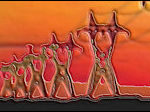The world economy is rapidly electrifying. Driven by new technologies and the environmentalist push to decarbonize the economy, an increasing share of the energy Americans consume will come out of the electric socket, reports the Wall Street Journal in a special report. “Instead of having fuels like natural gas or oil or gasoline flow directly into our homes, offices, manufacturing facilities and cars, those fuels — and other sources of energy — will increasingly be converted to electricity first.”
A Princeton University study finds that electrifying buildings and transportation could double the amount of electricity used in the United States by 2050, lifting electricity’s share of total energy from about 20% today to close to 50%.
Electrification offers the ability to harness renewable power sources, primarily wind and solar, to displace carbon fuels that contribute to global warming. But it does present the challenge of maintaining the integrity of the electric grid in the face of natural disasters, cyber attacks, and other challenges. While many environmentalists consider global warming to be an existential threat to humanity, a collapse of the electric grid accounting for 50% of all energy consumption would pose an equally existential threat to human well being — within the next two or three decades, not by the end of the century.
We’ve seen how the Polar Vortex stressed Virginia’s electric grid. We watched horrified to see what extreme cold did to a Texas grid unprepared for extreme weather. We’ve just lived through a ransomware cyber-attack that shut down a gasoline pipeline. We’ve been warned. If we’re going to rebuild our economy around the electrification of everything and create a single point of potentially cataclysmic failure, it is criminally negligent not to do whatever it takes to make sure it never fails.
Sections of the U.S. electric grid were built in the 1950s and ’60s and are approaching end-of-life conditions. The 2019 wildfires in California demonstrated how much of PG&E’s infrastructure needed to be repaired or replaced. The number of U.S. electricity outages has doubled over the past decade. Compounding the problem is the fact that the performance of wind and solar depend vary with weather conditions. They cannot be turned on and off as needed to match supply and demand and keep electric voltage and frequency in balance.
The Journal article explores three ways to deal with the reliability challenge: transmission lines, redundancy (backup power sources, including battery storage), and distributed energy.
One solution is to create more inter-regional connections so electricity can be wheeled to one location where the sun and wind are not cooperating from a functional power source two or three states away. The Biden administration proposes, as part of its massive infrastructure spending plan, to spend $8 billion in new high-voltage transmission lines and other grid improvements. That’s a drop in the bucket. According to the Journal, Princeton University estimates the country will need to double or triple its transmission capacity to meet the goal of net-zero greenhouse gas emissions by 2050.
The problem: No one likes high-voltage transmission lines, and new lines invariably generate intense opposition. Moreover, in their war against oil and gas pipelines, environmentalists have perfected a set of legal delaying tactics that can be turned against the transmission lines. The needed capacity may never be built.
Another solution is redundancy — paying companies to hold surplus power-generation capacity in reserve. The problem: maintaining that reserve in the form of natural gas-fired turbines, pumped-storage dams, or vast banks of batteries — in effect, an entire backup electric generating system — is incredibly expensive. I have yet to see an informed discussion of how much such a system would cost when electricity supplies 50% of all energy consumption.
A third alternative is a distributed grid. Businesses, homeowners and perhaps collaborative ventures such as eco-districts install their own generating capacity with clean energy sources capable of operating independently off the grid. Participants in the distributed grid can seal themselves off from the central grid if there is a power surge or shutdown that could fry their equipment, suggests the Journal. In theory, a distributed grid “is a way to reduce pressure on the grid as demand for electricity takes off.”
This is fabulist thinking. First problem: Distributed energy isn’t suitable for everyone. Not all buildings are structurally sound enough to accommodate solar panels; not all rooftops have southern exposure to maximize the capture of sunlight. Second problem: the installation of solar panels on individual rooftops is an artisinal, hand-crafted approach compared to the assembly line approach of building utility-scale solar farms. It is vastly more expensive. That’s why it hasn’t taken off and, absent enormous subsidies, never will. Third problem: If an extended extreme weather event causes electricity consumption to soar, or blots out the sun, or causes too much or too little wind to blow, that will affect rooftop solar and backyard windmills just like it affects utility-scaler solar and wind farms. Fourth problem: distributed energy violates the principle that a system capable of pooling electricity resources is more flexible and resilient than a system divided into impermeable cells.
I expect the reliability issue can be addressed, but it will be incredibly expensive. That’s because it must be 100% fail-safe. When Virginia gets 50% of its energy from the grid, the economy collapses when the grid goes down. Our COVID crisis was a summer breeze compared to the derecho that awaits.



